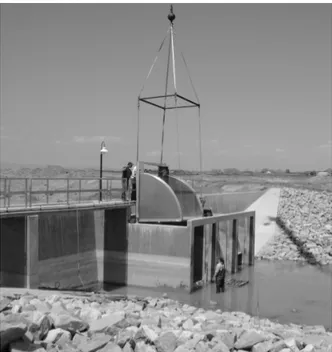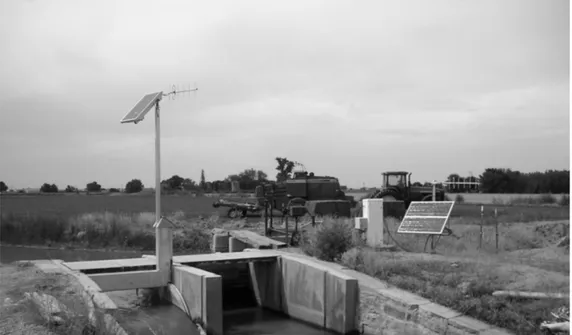235 Stephen W. Smith
ABSTRACT
New Cache La Poudre Irrigating Company (http://www.newcache.com/) began the first phases of modernizing the 114-year-old canal in recent years. The Company has built new equalizer reservoirs, a 30 CFS pump station, and a new 3,000 acre foot storage reservoir using concessionary loans available from the Colorado Water Conservation Board. Further, the outlet works out of the Company’s long-time equalizer reservoir on the Greeley #2 Canal has been replaced and modernized. As an integral part of the overall canal modernization, various approaches to actuating gates, measuring flows, and initiating SCADA were evaluated. The Company studied and toured SCADA installations in four states of the United States and in two states of Australia. Ultimately, the Rubicon actuated and flow measuring gates were selected and eight gates have been installed on the canal in the past two years. Portions of the Greeley #2 Canal, the river diversion on the Cache La Poudre River, and the discharges from two reservoirs can now be monitored and controlled from the Company’s office in Lucerne, Colorado. The process of evaluating SCADA and actuated gates will be described as well as current operations. Further expansion of the system is
anticipated in the future that will likely lead the Company toward full canal automation. The current short term strategy for future expansion of the system will be described.
BACKGROUND AND INTRODUCTION
New Cache La Poudre Irrigating Company (referred to here as NCLPIC or “the Company”) operates one of the larger canal systems in northeastern Colorado which is known as the Greeley #2 Canal. The company holds decrees on the Poudre River and diverts approximately 600 CFS when all the direct flow decrees are in priority. An affiliate company, managed under the umbrella of the New Cache companies, holds storage decrees as well. Further, many farmers under the Greeley #2 utilize owned or rented water in the Colorado-Big Thompson system which is the late season supplemental water in the region. In recent years, NCLPIC has also initiated a well augmentation plan for more than 80 member wells within the company’s historic service area.
1 Manager, New Cache La Poudre Irrigating Co., Lucerne, Colorado.
2 Chairman and Vice President, Aqua Engineering, Inc., 4803 Innovation Drive,
In 2003, the company commissioned an initial demonstration of SCADA (monitoring only) with one of the key rated sections on the Greeley #2 system. This demonstration complemented an existing Stevens recorder device and showed clearly that real time data could be effectively used and that improved monitoring was a significant help in managing day-to-day operations as well as annual reporting of flows and deliveries.
THE DISCOVERY PROCESS
After considerable SCADA study and evaluation, including tours of Central Arizona Irrigation and Drainage District, the Dolores Project near Cortez, Colorado and Imperial Irrigation District in California, the Company elected to implement SCADA for further monitoring of flows as well as gate actuation at key checks and reservoir outlets. Concepts of differing approaches were evaluated and costs estimated over an evaluation period of approximately 9 months. It was gratifying to learn that, in general, the costs of implementing SCADA for canal operations are down from the 1990’s when it was still quite costly to acquire many of today’s affordable features.
It is important to note that the Company took a suitable period of time and made very deliberate efforts to understand options and costs. The differences between Figure 1. The Greeley #2 Canal dates back to the late 1800’s and is one of the four
major canal systems on the Cache La Poudre River in northeastern Colorado. The canal is approximately 45 miles in length and provides irrigation water to
not only the technical specifications of differing equipment and the over riding philosophy are not easily understood.
Ultimately, the Company’s Board of Directors made the decision based on the evaluations and ideas presented to them in early 2005. One notable demonstration for the Board was related to the real time benefits of SCADA. During a March 2005 Board meeting, it was possible to log onto the Goulburn-Murray Rural Water Authority’s system in Australia to see water flowing. Because of the internet-based interface to this SCADA system, flow trends could be monitored and gates moved as a demonstration of functionality and remote access.
The Company continues to study potential expansion and future features for consideration. In the fall of 2006, Don Magnuson and Stephen Smith visited three irrigation districts in Victoria and New South Wales, Australia to better
understand the full or near full automation of canals that has been achieved there. ELEMENTS OF THE IMPLEMENTATION
Rubicon gates were ultimately selected because of suitably accurate flow
measurement that is possible combined with gate actuation in one structure. One existing radial gate was actuated with a Limitorque actuator and another with a Rotorque actuator. The RTU’s in the Rubicon gates and the other sites are Motorola MOSCAD units, either M or L devices.
Both spread spectrum and conventional UHF radio communications were
evaluated. After that process was completed, a UHF radio frequency was licensed to the company and the communications for the entire system are facilitated using a repeater on a water tower near the Company’s offices near Lucerne, Colorado and a tower on a property owned by the Company near Timnath, Colorado. The radio infrastructure is currently capable of providing radio coverage to the entire 35,000 acre service area under the Greeley #2 Canal.
Because Rubicon gates were selected, the Rubicon SCADAConnect HMI was evaluated and ultimately selected for the human-machine interface at the central computer. The system currently consists of eight Rubicon gates, two actuated radial gates, and monitoring of one rated section. A key radial gate outlet used to waste excess water in storm events allows for continuous monitoring of canal water surface elevations. Storm flows can be dumped to avoid increased liability and risk of a canal breach.
More specifically, the SCADA-driven elements of this canal modernization project include:
• Automation of a radial gate at the river diversion on the Cache La Poudre River.
• Automation of the outlet from Kern Reservoir, an equalizer on the main canal.
• Automation of two checks on the main canal.
• Monitoring of flows at a historic rated section on the main canal.
• Automation of a radial gate that can be used to release excess flows such as storm flows back to the river.
• Automation of diversions into equalizers on the lower end of the system as well as a pumping station.
FINANCING OF THE IMPROVEMENTS
The Colorado Water Conservation Board provides low interest loans for raw water related projects. The interest rate for a 30-year term loan has been 2-1/5% and this is likely to drop some in 2007. The program has been quite successful in encouraging ditch and canal companies to make much-needed improvements to their systems.
NCLPIC applied for a loan after completing an engineering feasibility study and was granted a loan for approximately $7m in 2004. Several years of design and construction improvements are coming to fruition during 2007.
FUTURE EXPANSION OF THE SCADA SYSTEM Currently, the operational scheme for the Cornish Plains project is being
developed and implemented. Cornish Plains consists of two equalizer reservoirs, a storage reservoir, and a pump station. The pump station is operated in either of two modes to 1) make up canal flow shortages in order to hit required
downstream deliveries or 2) pump water into the storage reservoir.
A short section of the canal at Cornish Plains will soon have Rubicon’s Total Channel Control (TCC) system implemented which will allow for a continuous and automated process. The pump station discharge will be varied over time to achieve a downstream delivery set point based on available flows in the canal. Further future implementation of TCC will be evaluated. Considerable expense time will be required if the Company is to automate more of the checks on the 45 mile canal and thereby allow for more TCC. It is also possible that individual laterals off the main canal will be considered for TCC. Costs and benefits are key to understanding future expansion of any of the system.
SUMMARY
For the New Cache La Poudre Irrigating Co., considerable deliberation and evaluation of hardware and software has culminated in the first phases of what will likely be a canal modernization effort spanning decades. SCADA is integral
to the improvements that have been made with a $10m total construction package that was financed ($7m) with low interest loans from the Colorado Water
Conservation Board. The process was enlightening and fulfilling and, most importantly, successful.
REFERENCES
Clemmens, A.J., R.J. Strand, and L. Feuer. 2003. Application of Canal Automation in Central Arizona. USCID Proceedings of the 2nd International Conference on Irrigation and Drainage, Phoenix, Arizona. 12 to 15 May.
Clemmens, A.J., R.J. Strand, L. Feuer, and B.T. Wahlin. 2002. Canal Automation System Demonstration at MSIDD. USCID Proceedings of the 2002
USCID/EWRI Conference, San Luis Obispo, California. 9 to 12 July. Hansen, R.D., B. Berger, and A. Hilton. 2002. www-Based Monitoring and Control for Over-Stressed River Basins. USCID Proceedings of the 2002 USCID/EWRI Conference, San Luis Obispo, California. 9 to 12 July. Magnuson, D., S.W. Smith, and M. Smith. 2006. Southeastern Colorado Contingent Tours Southeastern Australia for a Bird’s Eye View of Canal Modernization. Colorado Water, Newsletter of the Water Center of Colorado State University. December.
Oakes, A., and B. Rodgerson. 2003. Advanced SCADA Networks Optimize the Operation of Water Resource Management Systems. USCID Proceedings of the 2nd International Conference on Irrigation and Drainage, Phoenix, Arizona. 12 to 15 May.
Smith, S.W. and D.O. Magnuson. 2005. Moderately Priced SCADA
Implementation. USCID Proceedings of the 2005 USCID Water Management Conference, SCADA and Related Technologies for Irrigation District
Figure 2. One of three gates on the Greeley #2 canal is re-installed during the spring of 2007 following a repair that was accomplished over the winter when the
canal was out of operation.
Figure 3. Three gates operated concurrently can handle the 600 CFS flow delivered from the Kern Reservoir which is an equalizer on the Greeley #2 Canal.
Figure 5. As a storm event materializes, excess water is first pushed into the Lower Division up until the lateral reaches its maximum capacity. When the water surface level in the canal reaches a threshold setting, the radial gate will
open and excess storm flows will be released back to the river.
Figure 4. A bifurcation in the Greeley #2 has historically been used to move storm flows down preferred reaches of the canal and to serve as a place to waste excess
flows back to the river in order to avoid a breach of the canal. The photograph shows a Rubicon gate used to hold deliveries on a portion of the canal. A radial

